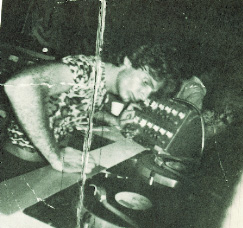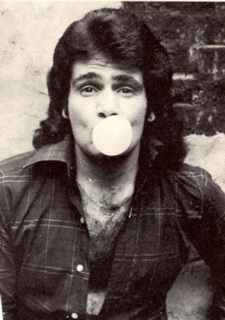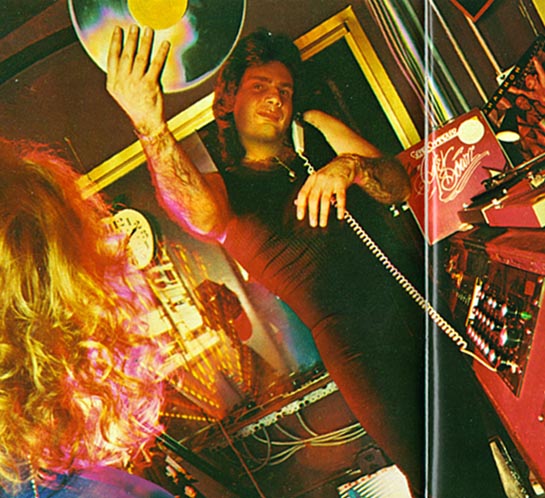Francis Grasso, the father of DJ culture, the modern nightclub DJ and nightclub music programming
Francis Grasso was one of the many unsung heroes in the dj world! He was the first dj to perfect how to slip-cue a record and release it on beat in order to create a non-stop mix of music in the nightclub scene. Yes, radio djs had used this technique previously, but not to create a continuous mix of music; furthermore Francis started paying attention to the energy and feeling of each song and began putting the songs together into sets that corresponded with the energy he was getting from the dancers on the floor. The more they gave off, the more he gave back. More importantly, he was the first dj to segue (or overlay) 2 records together in order to maintain a consistent flow of energy throughout the night while matching the beats of the music. Though these things seem simple by today's standards, in the late 60's and early 70's these techniques, along with his progressive and innovative programming style, were quite revolutionary and provided the basis for the rest of us who followed. All done with LPs and 45s! As these techniques started to spread, Francis worked with other djs, first the other DJs at the club with Francis, Steve D'Acquisto and Michael Cappello, and later as the news spread of how hot these guys were, Nicky Siano, Frankie Knuckles, Larry Levan, David Mancuso and Walter Gibbons. From there, it literally spread across the country and around the world. To this day there are elements of what these pioneers started within the framework of the modern nightclub DJ's sets.
From "Disco" by Albert Goldman, 1978.
"One of the greatest draws at Sanctuary was the only straight guy in the place, its legendary DJ, Francis. The most influential spinner in the short history of the craft, Francis Grasso is (sic) a small, muscular, long-haired lad from Brooklyn who got his start in the business working as a dancer at Trude Hellar's club in the Village, where he was obliged to perform on a narrow ledge against the wall that allowed him to move only laterally, like a figure in a frieze. One night while visiting Salvation II, a club perched on top of an apartment house on Central Park South (today, the site of the Bengali restaurant, Nirvana), Francis was asked to substitute for Terry Noel, who failed to show up for work. Grasso approached his trial with fear and trembling; but when Noel appeared, the manager fired him and hired the novice. Francis soon demonstrated that he had a fresh slant on spinning. Unlike Terry, who was heavy into rock and kept a picture of Elvis Presley stuck up in the booth, Francis worked the soul track. When he got up on the altar at Sanctuary, he would preach that old-time religion with Aretha Franklin, Gladys Knight, Booker T. and the MG's. Into this mix he would drop Chicago's and Cat Mother's Track In A. Once he had the crowd hooked, he'd dip into his African bag with Olatunji and the authentic Nigerian drums and chants of Drums of Passion. Francis was the first DJ to perfect the current technique for stitching records together in seamless sequences. He invented the trick of "slip-cuing"; Holding the disc with his thumb while the turntable whirled beneath insulated by a felt pad, he would locate with an earphone the best spot to make the splice, then release the next side precisely on the beat. When he got Thorens turntables with speed controls, he supplemented his cuing technique with speed changes that enabled him to match up the records perfectly in tempo. He also got into playing around with the equalization controls not only to boost the bass for ass-wagging but to compensate for the loss of highs that occurred when a record was slowed down for mixing. Eventually, Francis became a virtuoso. His tour de force was playing two records simultaneously for as long as two minutes at a stretch. He would super the drum break of I'm A Man over the orgasmic moans of Led Zeppelin's Whole Lotta Love to make a powerfully erotic mix that anticipated by many years the formula of bass-drum beats and love cries that is now one of the clich»s of disco mix. What this pioneering jock was doing was composing a hitherto nonexistent disco music out of prefab parts. What's more, he was forging the new music right in the heart of the discotheque, with the dancers freaking out in front of him and sending back their waves to his soul, exactly as Lindy dancers used to turn on jazz musicians in the old swing bands. Not a high-powered show-biz jock like Terry Noel, who wanted to sweep up the audience and carry them off on his trip, Francis was instead like an energy mirror, catching the vibes off the floor and shooting them back again recharged by the powerful sounds of his big horns. Eventually, Francis taught other jocks his tricks and established his style of playing as the new standard."
From suenomartino.net
"At the end of the 60's, as Berry Gordy as acting as the musical midwife for the birth of Diana Ross and the Supremes, Marvin Gaye and Smokey Robinson, as dj's in clubs were emulating their radio counterparts by talking after each record, a major change was about to take place: mixing was about to be invented. Francis Grasso was one of those figures who made the first contribution to the art of mixing. Like most pioneers, he went underpaid and, in his professional lifetime, unrecognised for his origination. Francis, who was of Italian origin, was born in Brooklyn in 1948 and began his career in show business as a dancer at a club in the Village (New York). One night in 1968, while visiting another club socially (the Salvation 2 in Central Park), the manager asked him to substitute for the resident DJ, Terry Noel, who was ill. Although he was not experienced, he had an immediate talent. Terry got fired and Francis got hired. Francis, who had started out some years earlier as a dancer, could actually understand what a crowd expected from a DJ. Because of a motorbike accident, he suffered from poor feet coordination and was urged by his doctor to take up dancing as therapy. Soon Francis found himself dancing in the best New York clubs. In addition to this, Francis had a musical background: when he was young he used to play guitar, drums and saxophone. There was something particular that characterised Grasso. He introduced soul music to the venue and suddenly people were dancing to Aretha Franklyn, Gladys Knight, Booker T. & the MG's etc. Although Francis didn't have vari-speed turntables at his disposal, his bpm selection married to his smooth performances sent the crowd crazy. For the first time ever the music flowed continuously with no DJ interrupting the dancefloor. While entertaining his crowd he had also experimented with the formula bassdrums and erotic moanings. In fact he would play the percussions of Chicago Transit Authority's "I'm a Man" with Robert Plant?s "Whole Lotta Love". Also, he would play classics by the likes of Olajunti (Drums Of Passion), Santana, Mitch Ryder & the Detroit Wheels, earlier productions by Earth Wind & Fire, The Staple Singers, Ike and Tina Turner, James Brown, Four Tops, Supremes, Temptations, Sam and Dave, Booker T. & the MG's, Sly and the Family Stone, etc. B.P.M was an unknown word to Francis: it was a feel for the mood, a cut at the right bar, a cross-fade at the right moment, until he got his first Thorens vari-speed turntables and then a new horizon came into his view. Before the introduction of this turntable, dj's couldn't adjust the speeds, so they had to cut at the right moment. There was no room for mistakes.
Nobody actually mixed like Francis, who developed an incredible skill for coming in with the right record at the right time. Francis had a natural talent for mixing records. Because of his ability and reputation, in 1969 he was offered a job at The Sanctuary, a former Baptist church located on West 43rd St. transformed into a disco. From his turntables placed on the altar, Francis taught the disco commandments to his followers, who celebrated his mastery of slip-cueing and mixing. The Sanctuary is also shown in a movie - 1971's 'Klute' (starring Jane Fonda), where you can see Grasso in action for a couple of seconds. Also back in 1969 he was spinning at Haven as well. After a while Francis decided to quit the Sanctuary,but he got back to it after a very short time. The reason why is not clear. It seems that somebody opened a club for Francis, and named it Francis. He decided to open his own club, and not play there, after agreeing to do so. Because of this he was beaten up. Devoid of ambition, Francis - the man who had virtually created disco and mixing as a new DJ attitude, continued working at the Sanctuary until it closed in 1972. Francis gave up deejaying in 1981 and spent his years in Brooklyn, occasionally working in construction. He passed away on March 20, 2001. He was found dead in his flat by friends."
GET THAT PERFECT BEAT; FACE MAGAZINE - OCTOBER 1983
New York disco and the men who made it by Steven Harvey. IT IS POSSIBLE (and tempting) to perceive the recent ascent of new dance music as an isolated pop/style phenomenon - something like punk or new wave - that has emerged over the last few years and snowballed into an international fad. Yet to under stand the new mood in NYC dance music, you must go back into its history. Back into the disco..
Escape into the disco: an underground pressure-valve from the work week. The names of some of the underground dance clubs in NYC in the early Seventies expressed this function - The Haven and The Sanctuary. Places where those relegated to the margins of society - blacks, latins, gays and kids - could affirm their own existence through the shared abandon of the dance. And central to the dance was the DJ.
At both The Haven in '69 and The Sanctuary in the early Seventies the DJ was Francis Grasso. Albert Goldman in 'Disco' describes how, without a cueing system, Grasso would overlay two different tracks, superimposing "I'm A Man" by Chicago over the bass and drums from "Whole Lotta Love"; mixing soul like Bobby Byrd and The Stovall Sisters into rock'n'roll and ethno-beat like Olatunji. His audience soon spilled through the doors of the huge former church into the streets, where the kids would hang out practising steps and doing drugs. Regularly the police would arrive to close it down, but attempting to clear the 1,000 or so people inside and the same number in the street would take hours.
Francis Grasso was one of the first in a line that runs through David Mancuso of The Loft to Larry Levan of The Paradise Garage, John "Jellybean" Benitez at The Funhouse and others.
From the liner notes of the Rhino Disco Box Set:
New York, Francis Grasso, The Sanctuary. "Back then, you couldn't adjust the speeds. You had to catch it at the right moment. There was no room for error. And you couldn't play catch up. You couldn't touch the turntables. I had Thorens, and you couldn't do that on Thorens. All you had to do was start at the right moment. Nobody mixed like me. Nobody was willing to hang out that long. Because if you hang out that long, the chances of mistakes are that much greater. But to me it was second nature. I did it like I walk my dog."
Francis Grasso (Obituary from the New York Times, Sunday April 8th, 2001.)
New York -- Francis Grasso, a pioneering club disc jockey credited with first mixing records together in the late 1960s by matching their rhythms, was found dead on March 23 at his home in Brooklyn. He was 52. The cause is unknown, pending results of an autopsy.
Mr. Grasso was born in Brooklyn and, at an early age, discovered a talent for music, playing drums, guitar and saxophone. After he was injured in a motorcycle accident, a doctor told him that dancing would be a good form of physical therapy, and soon he was a fixture on the Manhattan club scene.
In 1968 at a Central Park club called Salvation 2, Mr. Grasso went behind the turntables for the first time when the club manager asked him to fill in for the house DJ, who was ill. Soon, Mr. Grasso had the job.
With an understanding of the psychology of the dance floor, he slowly began to retool the job of the DJ. As he saw it, his job wasn't simply to play records, it was to keep the crowd on the dance floor. The best way to do that was to make one song seem to stretch on forever, without a break. This helped create the notion of the disc jockey as artist and live remixer. Working with two 7-inch singles, at first he would start a new song on the same beat that ended the previous song (by holding the record still as the turntable spun below it, a technique known as slip-cueing).
Later, he began matching the beats of records, trying to keep two songs playing simultaneously for as long as possible, which was an extremely difficult task since most turntables then lacked conveniences like pitch control.
One of his best-known tactics was his simultaneous playing of percussion- heavy songs, like Chicago Transit Authority's "I'm a Man," with sexually charged vocals, like Led Zeppelin's "Whole Lotta Love," anticipating the rise of disco.
Mr. Grasso developed and refined many of these techniques when he moved his headquarters to Sanctuary, a hedonistic club in the Hell's Kitchen section of Manhattan, and presided over the dance floor there until it was closed by city authorities in 1972.
In 1971 the movie "Klute" featured a scene with Mr. Grasso working at the Sanctuary. When the club closed, he worked as a DJ off and on until 1981, when he left the profession for good and found a job working in construction.
All articles and images are copyright by their respective authors. All images were scanned by myself possess identifying hidden information to stop theft. So when I google these images and find you have stolen them from here without proper credit, that officially means you suck!



